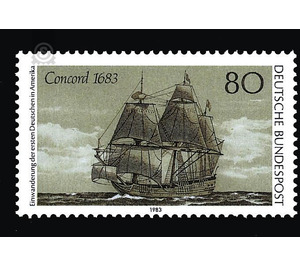300th anniversary of the immigration of the first Germans in America - Germany / Federal Republic of Germany 1983 - 80 Pfennig
Theme: Calender
| Country | Germany / Federal Republic of Germany |
| Issue Date | 1983 |
| Face Value | 80.00 |
| Color | brown |
| Perforation | K 14:14 1/4 |
| Printing Type | combined intaglio and offset printing |
| Stamp Type | Postage stamp |
| Item Type | Stamp |
| Chronological Issue Number | 1053 |
| Chronological Chapter | GER-BRD |
| SID | 862442 |
| In 55 Wishlists | |
The 300th anniversary of the immigration of the first Germans in America is reason enough to celebrate this historic event, which is so important for both countries, with a common, motif-like German-American stamp issue - the special stamps appear in both countries on the same day. The two stamps differ only by the German and American inscription. On October 6, 1683, 35 immigrants from Krefeld left Philadelphia, the capital of the newly founded English colony of Pennsylvania, aboard the English sailing ship Concord. The 13 leash weaving families settled together outside the capital, which only consisted of two streets. Two leagues from Philadelphia on an ancient Indian trail north, they cleared a dense oak forest to the right and left of the road, and the next year saw a village of 12 log cabins. Germantown became the first settlement of German expatriates in America. Their home in the Dutch-German border area had left the Krefelder Weber for religious and political reasons. As Dutch-speaking Quakers, they had endured hostility and harassment for years; in the Quaker colony of Pennsylvania, however, they had the authorities entirely on their side. They did not come as destitute adventurers, but had prepared the relocation through land purchase contracts. On her arrival, she was awaited by the previously traveled Franz Daniel Pastorios (1651-1720), a Pietist intellectual and multilingual lawyer from Franconia. He had negotiated for the purchase of no less than 15,300 "acres" (612 km2) of woodland in the vicinity of Philadelphia for the "Pennsylvania Company" of Frankfort Pietists and for the Krefelds with William Penn. For Germantown, 5,700 "acres" (228 km2) were reserved, and the first 13 families initially purchased 200 "acres" each (80 hectares). Because no settlers came from Frankfurt, Pastorius joined the Krefeldern. He became the first mayor of Germantown, which in a few decades developed into a flourishing settlement with a religious and ethnically diverse population of Quakers, Mennonites, Pietists, Reformed and Lutherans. Of the 397 inhabitants of Germantown in the period 1683-1709 came 96 from Krefeld and the neighboring Kaldenkirchen, 41 from the Palatinate near Worms (Kriegsheim, Flomborn, Wollsheim), 55 from various other German places, 63 from the Netherlands (Amsterdam, Haarlem and other places); Of 114 inhabitants is not sure whether they came from Dutch or German places, 17 came from England and 11 from other European countries. Germantown did not become a silent, German exclave, but more of a multicultural transit camp for socially and geographically mobile immigrants and inland immigrants. In Germantown, for example, the same process of adaptation to the dominant English-speaking culture took place in small, which has since made the following over 7 million immigrants from German-speaking countries into Americans. The overwhelming majority of very heterogeneous German immigrants and their descendants sought freedom in the New World from need and oppression and freedom for personal development; Opening to the English-speaking environment, most of them soon recognized it as a basic requirement for achieving that goal. How many Germans and how many Germans have influenced American society in the course of this three-hundred-year process, of which there are countless examples in all eras and areas of American history, from the time of the War of Independence to the civil war until the 20th century, from the development of the West, the fight against slavery, administrative reforms to the development of the arts, science and technology. (Text: John F. Kennedy Institute for North American Studies, Freie Universität Berlin, Department of History, Prof. Dr. Willi Paul Adams)


